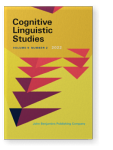Vol. 9:2 (2022) ► pp.361–400
An explanation of causal-noncausal verb alternations in terms of frequency of use
A diachronic approach to English sound emission verbs
To account for the cross-linguistic trends in the coding of causal-noncausal verb pairs, such as break (tr.)/break (intr.), Haspelmath et al. (2014) proposed, and provided corpus-based support for, an explanation in terms of usage frequency (Prediction 1, hereafter P1). However, this explanation cannot be applied to English causal-noncausal verb pairs. Since English mostly uses the same verb form for the causal and noncausal verb use, the explanation does not follow the form–frequency correspondence principle (hereafter FFCP) that Prediction 1 (hereafter P1) is based upon. In this article I argue, by using causative-affixed verbs, that for a linguistic pair there is a strong correlation in terms of frequency between form and earlier occurrence. Therefore, in place of the FFCP and P1, I propose the earlier occurrence – frequency correspondence principle (hereafter EOFCP) and the Revised Prediction 1 (hereafter RP1) based on it. This study tests the validity of the EOFCP and RP1 by applying them to 20 English verb pairs of sound emission. The investigation of frequency was made not only in present-day English but also at the time when the intransitive or transitive use came to be paired with its counterpart. The analysis shows that by applying the RP1 to the frequency data at the two time periods, we can obtain considerably high scores of matching rate, with a significant Spearman rank order correlation between the two groups.
Article outline
- 1. Haspelmath et al. (2014) and the aims of this study
- 2.An overview of this study
- 2.1Target of this study
- 2.2Determination of the pairing time period
- 2.3How to extract from corpus sources
- 2.4Decisions on metaphorical extensions and verb forms
- 2.5Five major research questions
- 3.Form/ earlier occurrence – frequency correspondence principle and revised Prediction 1
- 3.1A strong correlation between form and earlier occurrence in time
- 3.2From Prediction 1 to revised Prediction 1
- 4.On noncausal vs. causal prominence
- 4.1Does a transition from Figures 2 to 1 come from a corpus size difference?
- 4.2Is the transition from Figures 2 to 1 the result of a historical change?
- 5.Three correlations measured in terms of Spearman’s rank order correlation coefficient
- 5.1Rank order correlations between “earlier occurrence” and “frequency”
- 5.2Rank order correlation between the CU Group and the PTP Group
- 6.Conclusions
- Acknowledgements
- Notes
-
References
